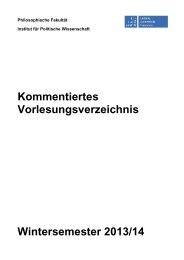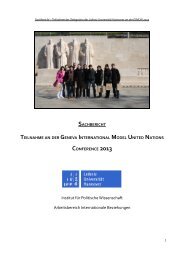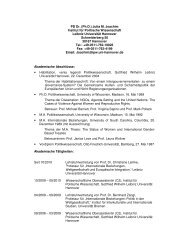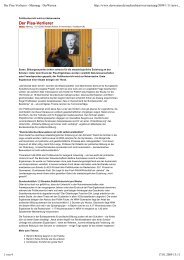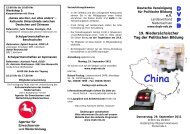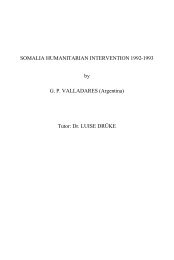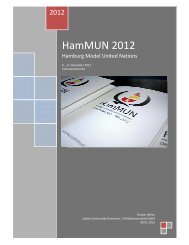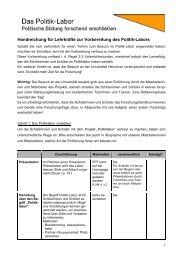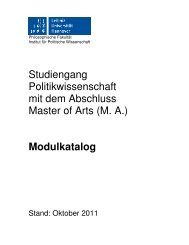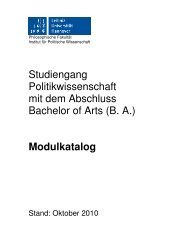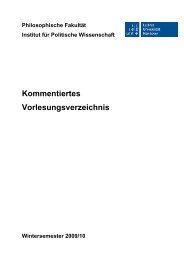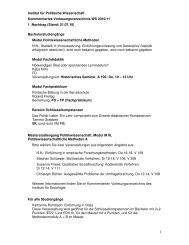Preventive Action for Refugee Producing Situations
Preventive Action for Refugee Producing Situations
Preventive Action for Refugee Producing Situations
You also want an ePaper? Increase the reach of your titles
YUMPU automatically turns print PDFs into web optimized ePapers that Google loves.
124 Chapter 3 Analytical Discussion 125<br />
The dearth of roads and communication infrastructures in the Mosquitia,<br />
which basically consists of one road and otherwise rivers, has created one<br />
of the most difficult challenges <strong>for</strong> UNHCR to monitor and attempt to<br />
prevent <strong>for</strong>ced recruitment. Those Miskitos successfully blocked from<br />
voluntary repatriation and unable to reach out to UNHC <strong>for</strong> assistance<br />
have been in serious danger of being <strong>for</strong>cibly recruited Indian contra<br />
groups. This problem started when the first refuge wanted to return after<br />
the amnesty in 1983, and remains acute today.<br />
UNHCR has worked on confidence-building measures among those<br />
who wished simply to live in peace and work the land made available to<br />
them through the government of Honduras <strong>for</strong> self-sufficiency projects;<br />
but since UNHCR is perceived as an "enemy" of KISAN, refugees who<br />
were cooperating with UNHCR in its assistance programs have tended<br />
suffer consequences. The large numbers of women with small children<br />
who were left behind in the refugee locations suggested that many male<br />
and single females were taken <strong>for</strong> <strong>for</strong>ced labor or even thrust into zones<br />
of combat.<br />
Concluding remarks<br />
As a human rights worker put it, KISAN and its U.S. advisors cynically<br />
relied on UNHCR and intended to instrumentalize the good offices of<br />
UNHCR to take care of the refugees they created. Their manipulation of<br />
international relief organizations was a shameful waste of precious and<br />
limited international relief resources, as well as a misuse of UNHCR,<br />
which was not designed to care <strong>for</strong> make-believe refugees - that is,<br />
arbitrarily generated ones. Miskitos and other indigenous groups who<br />
were pushed into Honduras at Easter 1986 had well-founded fears of<br />
persecution by KISAN if they refused to let themselves become refugees.<br />
These persons were more in danger where they were going than in the<br />
country from which they supposedly fled: the danger came from the<br />
guenillas who presumably were fighting <strong>for</strong> them. 285<br />
It is not UNHCR's usual task to involve itself in the causes that make<br />
people gravitate toward refugee camps. It might, however, have been<br />
possible to provide U.N. and non-U.N. policymakers with a more com-<br />
prehensive analysis of the motives and to offer recommendations on how to<br />
confront the Spring 1986 influx. Of course, UNHCR is operating in<br />
Honduras in a highly sensitive context. If the Office was unable or unwilling<br />
to make a more systematic collection of in<strong>for</strong>mation, concerning the<br />
causes of the announced movement <strong>for</strong> early analysis and action, UNHCR<br />
might have been able to indicate these problems in a general manner to<br />
researchers from public interest organizations, such as Cultural Survival, or<br />
experts on indigenous people, so as to establish the facts in an objective and<br />
reliable manner. That way UNHCR would not be directly associated with<br />
the investigation; in any event, it would not need to pass judgment on the<br />
result of these findings or on those responsible <strong>for</strong> the acts committed.<br />
UNHCR might have been in a good position to express its concern about<br />
the impending situation, in the interest of the persons <strong>for</strong> whom it was<br />
expected to provide protection from the authorities. If UNHCR had been<br />
prepared to take preventive action, its resources of international<br />
humanitarian assistance would not have been used to maintainigroups of<br />
people who would probably not have received it under different circumstances.<br />
Apart from sparing UNHCR's energies, it is likely that many of the<br />
8,000 Nicaraguan Indians who entered UNHCR's refugee location<br />
subsequent to the initial interviews would not have needed to cross the<br />
border. A proof <strong>for</strong> this assumption is that approximately 8,000 of the "new<br />
refugees" wanted to go back to Nicaragua after having barely arrived with<br />
the Spring 1986 influx. 286 Many of them stated that they had not wanted to<br />
come into Honduras, and decided to spontaneously return across the border.<br />
Those who were impeded by KISAN or preferred to repatriate officially<br />
under the auspices of UNHCR did so, which brought the figure <strong>for</strong> 1986<br />
UNHCR assisted repatriations to 1,714. With better facilities in place, and<br />
negotiations between the Nicaraguan, Honduran, and UNHCR authorities<br />
successfully concluded in a tripartite agreement allowing <strong>for</strong> large-scale<br />
repatriations, the UNHCR assisted repatriation figures <strong>for</strong> Miskitos and<br />
Sumos jumped to 3,873 in 1987, and to 7,994 during the first nine months of<br />
1988. 287<br />
The High Commissioner himself and, if necessary, the UN Secretary-<br />
General should have been kept better in<strong>for</strong>med of the situation in a direct<br />
and continuous manner. They might have wanted to arrange <strong>for</strong> more<br />
War By Both Sides in Nicaragua In 1987," (Washington,D.C. November 1987),<br />
p. 52<br />
285 Interview with anonymous human rights worker, on the handfile of the<br />
author, p.<br />
________________________<br />
286 The New York Times, 18 April 1987.<br />
287 UNHCR, "Comparative Repatriation Statistics in Central America and<br />
Mexico," Jan.-Dec. 1987, Jan-Sept. 1987, Jan-Sept 1988, October 1988/AW.



